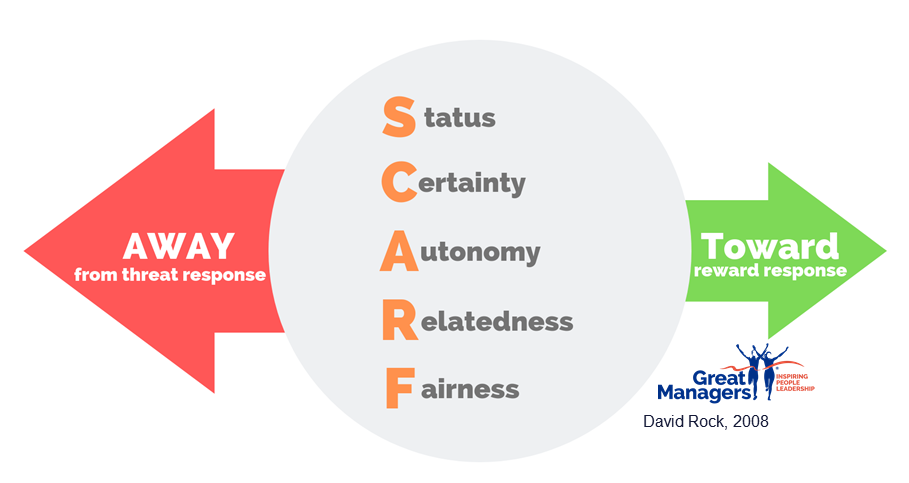How to Deal With Defensiveness (The SCARF Model)
Sometimes the hardest thing about managing people, particularly in relation to performance conversations and providing feedback, is dealing with defensiveness… the other person’s and your own!
While defensiveness is a ‘normal’ human behaviour it can get in the way of our ability to communicate with others and achieve our desired outcome.
It can feel like we’re going around in circles… or backwards even.
It can be incredibly frustrating!
However, if you know how to identify Defensiveness, understand it and handle it in an effective way before it takes hold, your discussions can be focused on the future, on solutions and next steps, as opposed to being stuck in protectiveness, the past, and who’s to blame.
This MasterClass is all about How to Deal with Defensiveness in a skilful, emotionally intelligent way.
You can now enrol in this full-length course on Udemy, click here to claim a limited time discount.
What is Defensiveness?

- Our first definition is that it’s a position, or attitude, of defence or resistance.
- It’s also defined as being excessively concerned about the real or imagined threat of criticism, injury to one’s ego or exposure of one’s shortcomings.
We need to be able to recognise the signs.
Understanding the mechanics of the mind, and how the brain works, is critical to learning how to manage yourself and develop new behaviours for dealing with Defensiveness.
Let’s have a look at some different signs of Defensive behaviour…
How to Recognise the Signs of Defensive Behaviour
1. Rationalising
Rationalising can also be identified as explaining yourself & making excuses.
With this pattern, you might find yourself saying:
“yes, BUT…”
an awful lot.
Someone might make a comment, and you say “yes, BUT!” and you’ll explain why you have to do things the way you do or explain why the other person is wrong.
You feel that you have to justify your behaviour and act as though their questions or comments are attacks on you.
If someone expresses their feelings, for example, someone might say to you:
“I’m really disappointed that you can’t come to our lunch”
You’d end up getting upset with them and explaining the numerous reasons why you can’t go to the lunch rather than just acknowledging that this person is going miss you at the event.
2. Blaming
 When Blaming, you shift the focus away from yourself by making the other person, or the people, the reason for your behaviour or the way you feel.
When Blaming, you shift the focus away from yourself by making the other person, or the people, the reason for your behaviour or the way you feel.
For example, if you didn’t get to work on time it’s because someone didn’t wake you up or you just missed the bus because the insensitive bus driver didn’t stop when he saw you.
It is always someone else’s fault with this pattern.
3. Attack and Counter Attack
You might complain about a problem you’re having to someone and when they give you some insight into the role you play in the problem, you attack or judge the person.
You say; “huh?” you feel indignant, you feel wounded or misunderstood by the suggestion that you might play a role in your own problems.
And you might accuse them of being mean and insensitive or you counter-attack by drawing their attention to something that they’re struggling with and how ineffective they have been.
4. The Need to be Right
 The need to be right can also be identified as the need to make others wrong.
The need to be right can also be identified as the need to make others wrong.
This is characterised by a tendency to see why things won’t work or point out flaws.
This can take a few different forms.
- It can be an oppositional style which is characterised by stubbornness, sarcasm, cynicism. You know the one: “…as if that’ll work!”
- It can be a controlling authoritarian style where it can only be done one way: “it has to be done this way!”
- It can be a competitive style which is what we call a win-lose mindset where you need to beat the other person, you always need to be one-up on the other person.
Dealing with Defensiveness is an “Inside” Job
You’ll never handle Defensiveness in others well if you can’t handle your own Defensiveness, or at least notice when that self-protective system is firing up.
Self-awareness must come first.
You must tune-in to yourself and be able to read the signs.
As you work on shifting from the automatic self-protective behaviours, you’re strengthening your self-actualising system.
This requires that you develop your observing self.
Start by asking yourself, “What am I feeling?” and then labelling the feeling.
This is important.
This is part of self-management and if you can’t do this immediately you might need to notice what behaviour you are displaying or contemplating.
For example, are you shutting down emotionally or are you winding-up emotionally?
It’s important to notice and label this feeling because this will help quiet down the amygdala – the emotional brain.
The next thing to do is tune-in to your body, your physiology.
Notice, with the observing self, what’s happening in your body?
Is your breathing shallow? Is your heart pounding? Are your muscles tense? Because the first sign of Defensiveness might be an emotion, or it might be a bodily sensation, it might be like a jolt of energy where you feel the protectiveness kick in.
There will be thinking going on behind this but it’s normally not conscious.
To regain control, you need to make this thinking conscious.
This is what self-management is all about.
Making these thoughts conscious, fires up the higher role or clever part of the brain called the prefrontal cortex. We’re using that emotion to guide thinking.
Curiosity is a very valuable emotion.
Dealing With Defensiveness – The SCARF Model
One of the most useful models I’ve come across to deal with my own defensiveness and that of others is the SCARF Model, developed by an Australian neuroscientist called David Rock.
 He identified what he calls our “modern-day threat responses.”
He identified what he calls our “modern-day threat responses.”
These are the things that trigger our fight/flight instinct, or self-protective system, the most in our modern-day workplaces and world.
This model helps us understand the unconscious drivers of human behaviour, and to get to the cause of Defensiveness.
If we don’t have a framework like SCARF, all defensiveness can look the same, and we’ll deal with it all in the same way. We’ll use a one-size-fits-all approach. Or, we can be triggered into using the same behaviour as the other person, without being aware of it.
Behaviour breeds behaviour.
Now, the five modern-day threats identified by David Rock are:
- Status
- Certainty
- Autonomy
- Relatedness
- Fairness.
The reality is that when we’re being Defensive, the fight/flight instinct is activated and we’re having what’s called a “threat response.”
Our primitive brain thinks we’re unsafe, and our ability to think clearly and solve problems is diminished.
Our brains are not working optimally.
Our emotional brain is up-regulated, and our clever brain is down-regulated.
We’re in survival mode.
Now, these threats light up in the brain the same way that physical pain does.
So, our brain perceives a social threat with the same intensity as an actual physical threat.
We get hijacked by our brain.
It’s only when we can pull up that threat response, that we can move towards what’s called a “reward response,” which means our brain chemistry has shifted into a positive register and our clever brain, the prefrontal cortex, is now active.
This part of your brain loves questions.
That’s why we ask ourselves these questions:
- “What am I feeling?”
- “What am I thinking?”
- “What’s that about?”
- “How else can I think about this?”
Because these questions switch on your prefrontal cortex.
This part of your brain allows your thinking to become solution-focused, and it feels good.
When you can help others move out of threat towards reward, they start working with you rather than against you.
Being able to identify and pull up a threat response is a very skilful approach.
It’s emotional intelligence in action. As a leader, it’s important to be able to influence the behaviour of others in the right direction, so we tune in to what the other person is doing and saying.
What is Status Threat?
A Status Threat is about relative importance to others or our credibility.
If someone is having a Status Threat, they feel diminished in some way.
To move them away from threat towards reward, we need to acknowledge or affirm them in a genuine way.
Now, in that moment, your ego will not want you to do this, but it works. Just try it!
What is a Certainty Threat?
A Certainty Threat is about being able to predict the future.
If someone is having a Certainty Threat, they may say something like,
“No one ever tells us anything around here!”
And rather than getting defensive back and telling them how many times you’ve told them, you might say instead,
“What information do you need?”
Because that question is going to get them into solution-mode.
What is an Autonomy Threat?
Autonomy provides a sense of control over events.
If someone is having an Autonomy Threat, they’re going to feel like they’ve had no input or have no control.
In this situation, it’s a good idea to give them a choice.
You might say something like:
“Well, we could do X or Y. Which do you think would work best?”
What is a Relatedness Threat?
Relatedness is a sense of safety with others. Friend, rather than foe… a feeling of belonging.
It’s very important that leaders demonstrate that they are friend rather than foe, and can build trust with a wide range of people.
I’m not suggesting here that you need to become their friend and start socialising with them.
You need to demonstrate that you are safe, that there is trust and respect in that connection with the other person.
Your communication skills and emotional tone play a very significant role in this.
What is a Fairness Threat?
Fairness is a perception of fair exchanges between people.
As a leader, you need to be consistent with your people. Otherwise, a fairness threat will be activated.
People will say things like:
“That’s not fair!”
Because we’re hardwired to sniff out injustice or unfairness and Defensiveness will ensue if this is the case.
Being consistent is incredibly important.
Next Steps
We cover the SCARF Model in quite a bit of detail in our training program, the Great Managers Academy.
For the full-length version on Dealing With Defensiveness, enrol in our Udemy course today. Click here for a limited time discount.








